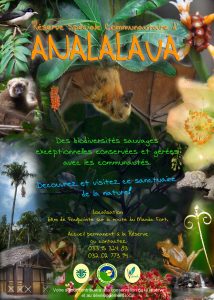Location
Morarano, Foulpointe, Tamatave Region, Atsinanana Province, Madagascar
Community Description
The Special Community Reserve of Analalava (Velonala and Missouri Botanical Gardens) is a protected rainforest on the east coast of Madagascar, owned by the local community, and managed by the forest association Velonala with the assistance of Missouri Botanical Gardens. It is home to five species of lemur, three species of flying fox, fifty bird species, chameleons, frogs, and 353 plant species (including 10 found nowhere else in the world). In spite of its biodiversity and close proximity to a popular beach destination, the reserve currently receives only a few dozen tourists annually on account of it still being rather new and underdeveloped.
There is hope within the community that an increase in ecotourism will be an economic boon for local people, most of whom earn just over a dollar a day. Improving facilities and staff capacity at the reserve has become the primary concern of the Peace Corps Volunteer at the site, who is working to train guides from local villages, fix trails, and build housing for visitors. A Peace Corps Partnership project with these objectives is currently underway.
The hand pump at the reserve breaks often, does not provide enough water, and brings up residual iron material from the pipe.
Project Description
This project is to replace a broken hand pump at the site with a sealed well lined with concrete rings, and an electronic pump.
The well will be dug to a depth of 4.5 m where water is plentiful (very high water table on the east coast of Madagascar). Reserve staff and community members will dig the rings into the ground by digging inside a ring so that it descends gradually as the earth is removed. Once a ring is flush with ground level, another ring will be added and the two will be fused together with cement. This process will continue until the well is finished. At this point, the well will be emptied entirely and a sand and gravel filter will be added to discourage silt and other material from entering the well.
The concrete rings (10 cm thick, 1 m in height, 80 cm in diameter) will be made in a nearby larger town, 7 km away, and driven by truck to the site. This is more economically efficient than transporting individual materials and a mold to the site. Sand left over from other community projects will be used to make the cement that will seal the rings together.
While there is no electricity on site, the electronic pump will be powered by an on-site generator which will be turned on for a few minutes once a day. Water will be drawn through a pipe up to an existing tower where two 200 L barrels sit and feed water to the various facilities around the site.
Water Charity funds will be used to buy and transport 5 concrete rings, a thick cement cover, buckets and rope, and piping. Any money left over will be contributed toward the purchase of the electronic pump. The Reserve’s partner NGO already agreed to cover the remaining cost of the electronic pump.
 Project Impact
Project Impact
This project will immediately benefit 150+ people. It has the potential to benefit thousands of tourists in the future.
Peace Corps Volunteer Directing Project
Andrew Bourret
Comments
The project will provide staff and visitors with a clean water source. It is essential to the future of the reserve, as tourists will come and stay if the facilities are up to the same standards as hotels in the nearby beach town.
Andrew previously completed the Morarano Well Project – Madagascar, which is very similar to the instant project, and the Morarano Public Latrine Project – Madagascar.
Dollar Amount of Project
$550.00
Donations Collected to Date
$550.00
Dollar Amount Needed
$0.00 – This project has been fully funded through the generosity of friends and family of Peace Corps Volunteer Andrew Bourret.
We encourage others to continue to donate using the Donate button below, and we will notify Andrew of your donation. Additional funds will be used to fund the next project by Andrew and/or those of other PCVs in the country of service.
![]() This project has been finished. To read about the conclusion of the project, CLICK HERE.
This project has been finished. To read about the conclusion of the project, CLICK HERE.